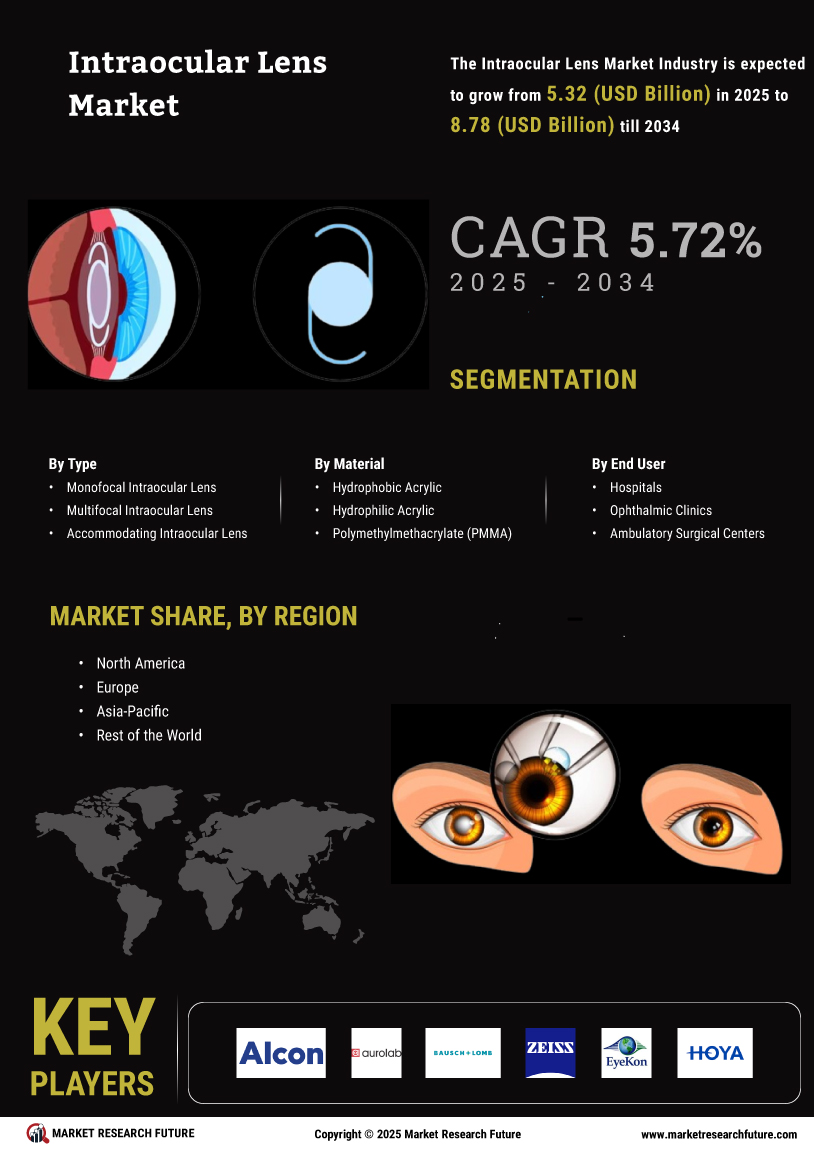Intraocular Lens Market Product Type Insights
The Global Intraocular Lens Market is experiencing significant growth, with its valuation expected to reach 4.64 USD Billion by 2024. Within the Product Type segment, various categories, including Monofocal, Multifocal, Toric, and Accommodating lenses, are instrumental in shaping the market dynamics. Monofocal lenses, which are designed for clear vision at a single distance, hold a majority share, boasting values of 2.32 USD Billion in 2024, and are projected to grow to 3.5 USD Billion by 2035. Their widespread use results from their effectiveness and affordability, making them a preferred choice for many patients undergoing cataract surgery.
Multifocal lenses are valued at 1.32 USD Billion in 2024, with expectations to expand to 2.0 USD Billion by 2035, as they provide patients with the ability to see clearly at multiple distances, thus enhancing the quality of life.
The increasing prevalence of presbyopia among the aging population fuels the demand for these lenses, reflecting a significant opportunity in the market. Toric lenses, which correct astigmatism, are valued at 0.8 USD Billion in 2024 and are forecasted to rise to 1.2 USD Billion by 2035.This segment is gaining traction due to the increasing awareness of astigmatism correction among consumers, making it vital within the intraocular lens market.
Accommodating lenses, although currently valued at 0.2 USD Billion in 2024 and expected to grow to 0.5 USD Billion by 2035, remain a niche product focused on mimicking natural accommodation, representing innovative solutions in vision correction. Collectively, these segments underscore the diverse needs within the Global Intraocular Lens Market, highlighting opportunities for advancements and tailored solutions while also positioning the market for sustained growth driven by technological advancements and the rising number of cataract surgeries performed globally.
The market growth is also propelled by factors such as an increasing aging population, the rising incidence of eye disorders, and advancements in lens technology, which cater to the evolving patient needs effectively. Overall, the segment composition illustrates a balanced market landscape that is geared towards addressing a broad spectrum of vision correction needs.

Source: Primary Research, Secondary Research, Market Research Future Database and Analyst Review
Intraocular Lens Market Material Type Insights
The Global Intraocular Lens Market, valued at 4.64 billion USD in 2024, is experiencing significant growth driven by advancements in ocular surgeries and an increasing aging population worldwide. Within the Material Type segment, Acrylic materials are known for their biocompatibility and adaptability, making them a preferred choice among ophthalmic surgeons. Silicone lenses offer flexibility and improved patient comfort, presenting unique advantages in various clinical scenarios. PMMA lenses, although utilized less frequently, remain significant due to their long history of reliability, particularly in developing regions.Hydrophilic materials are gaining traction due to their ability to retain moisture, enhancing patient comfort post-surgery.
The diverse material properties play a crucial role in determining the performance and outcomes of intraocular lens procedures, reflecting the growing demand for customized solutions catering to individual patient needs. As the Global Intraocular Lens Market statistics show steady growth, understanding the Material Type segmentation becomes vital for stakeholders aiming to capitalize on emerging trends and opportunities in this evolving industry.
Intraocular Lens Market Surgery Type Insights
The Global Intraocular Lens Market is poised for significant growth, particularly in the surgery-type segment, which is essential in addressing visual impairment conditions such as cataracts. By 2024, the market is projected to reach a valuation of 4.64 USD billion, highlighting its importance in the ophthalmology sector. Within the surgery type framework, Phacoemulsification, Extracapsular Cataract Surgery, and Intracapsular Cataract Surgery are integral methods employed across global healthcare systems.
Phacoemulsification is widely recognized for its efficiency and minimal invasiveness, leading to quicker recovery times which greatly enhance patient satisfaction.Extracapsular Cataract Surgery retains a significant market presence due to its effectiveness in complicated cataract cases. Intracapsular Cataract Surgery, although less common, is crucial for specific patient populations driven by factors such as advanced cataracts or prior surgeries.
The growth of these surgical methods can be attributed to the rising global prevalence of cataracts, an aging population, and advancements in surgical technologies. Moreover, increasing awareness about eye health and the availability of advanced surgical techniques support the continued development of this market segment.The Global Intraocular Lens Market statistics reflect a comprehensive understanding of these surgical methodologies and their critical role in visual rehabilitation.
Intraocular Lens Market End-Use Insights
The Global Intraocular Lens Market segmentation by End Use highlights key areas of operation such as Hospitals, Eye Clinics, and Ambulatory Surgical Centers. In 2024, the overall market is expected to be valued at 4.64 billion USD, reflecting the growing demand for innovative lens technologies driven by an increase in cataract surgeries and an aging population. Hospitals often dominate this segment due to their comprehensive capabilities, allowing them to provide advanced surgical procedures and technologies.
Bionic Eye Clinics serve as significant providers of eye care services, focusing on personalized patient treatment plans, and are crucial in expanding the outreach of intraocular lens procedures.
Meanwhile, Ambulatory Surgical Centers are becoming increasingly important due to their ability to offer cost-effective and efficient surgical options, driving patient satisfaction and convenience. Overall, these End-use areas are vital contributors to the global landscape of the Intraocular Lens Market, showcasing diverse patient care models that continue to evolve in response to healthcare trends and technological advancements. Factors such as increased patient awareness and advancements in lens materials further drive the market growth within these segments.











